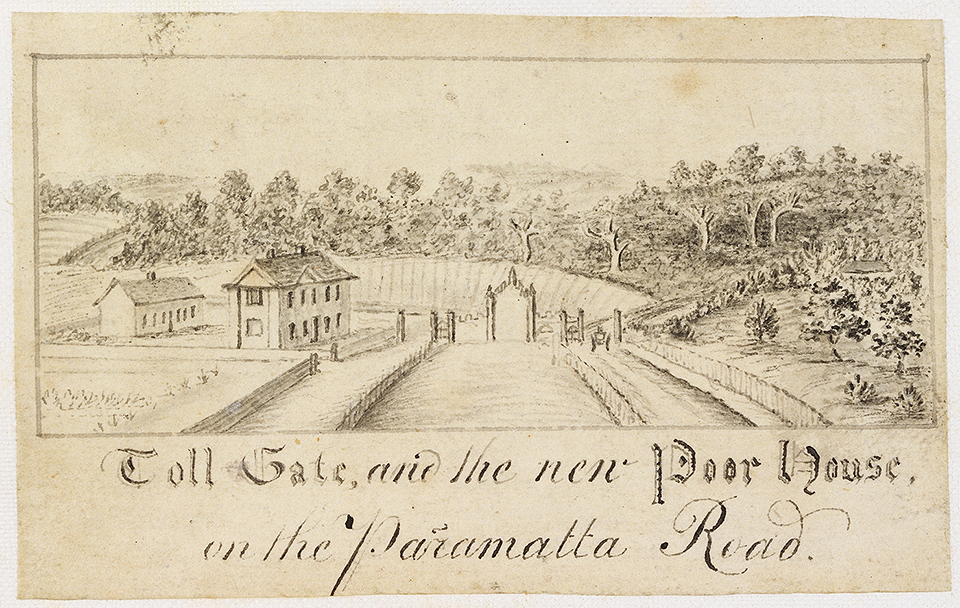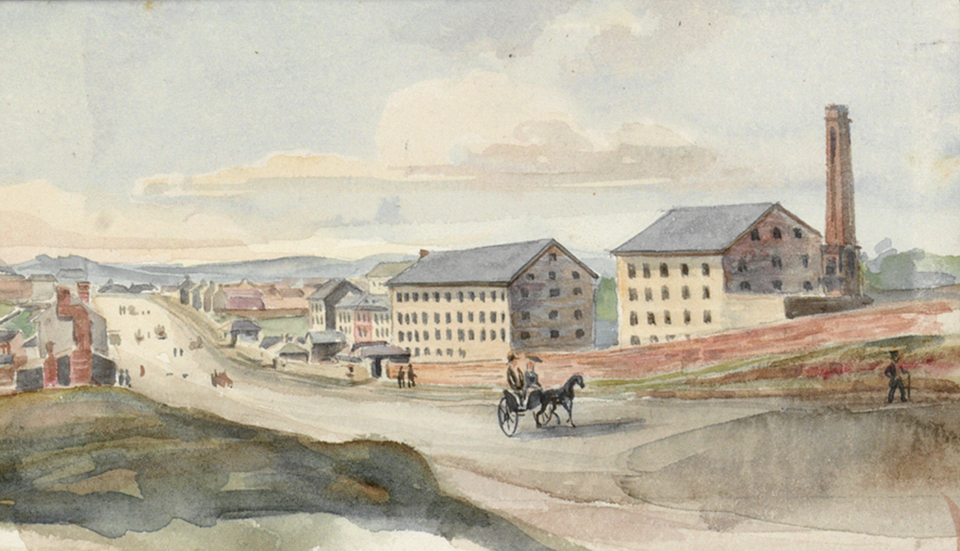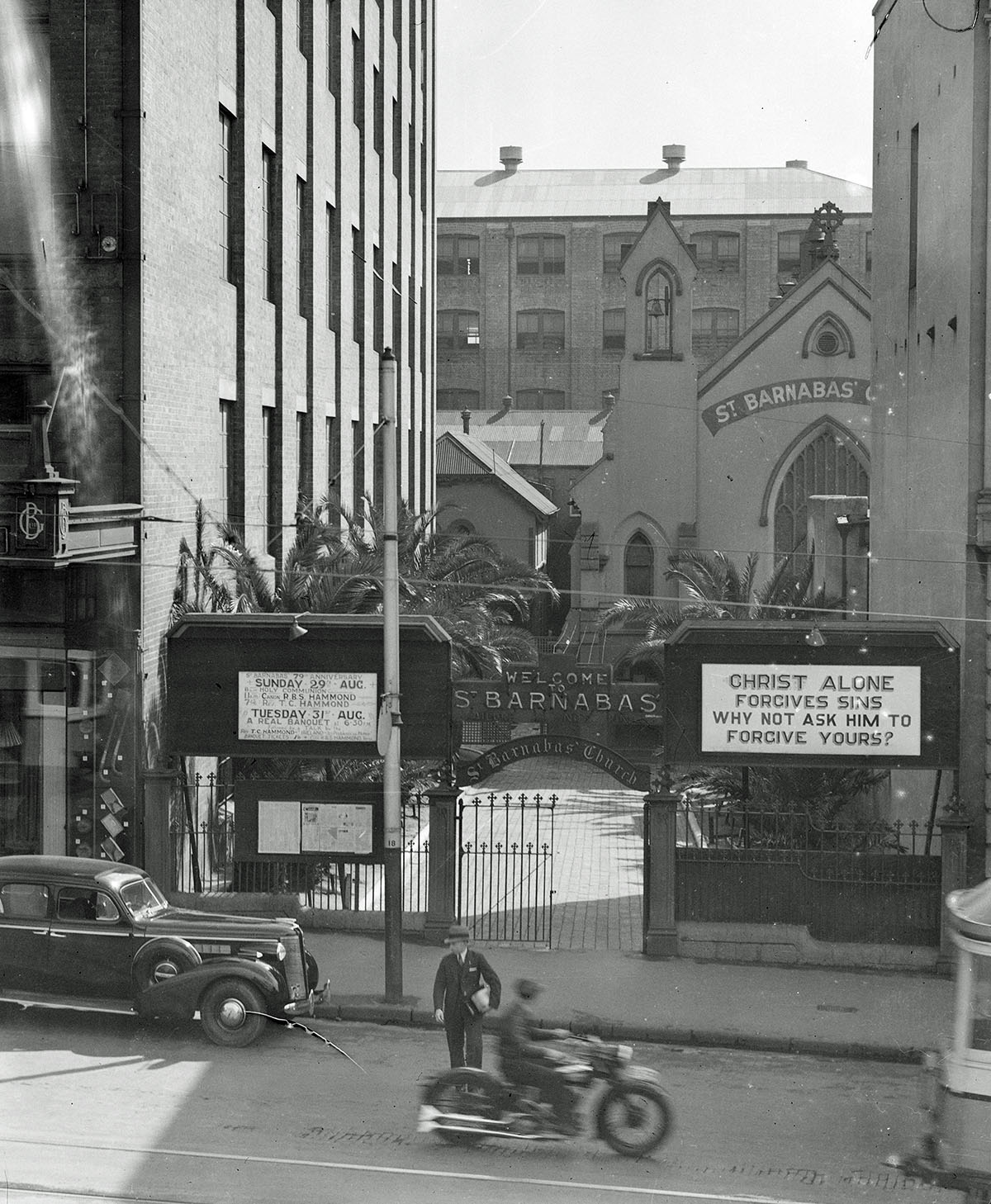The Dictionary of Sydney was archived in 2021.
Broadway
Citation
Persistent URL for this entry
To cite this entry in text
To cite this entry in a Wikipedia footnote citation
To cite this entry as a Wikipedia External link
Broadway
[media]Broadway was formerly called George Street West, and before that Parramatta Street.
Streets are places with local residences and functions. Roads are going to somewhere else, and are often named for that place, as in Parramatta Road, the name given to the roadway leading out of Sydney and heading towards Parramatta.
George Street was the original high street of Sydney. It converged with Pitt Street at the toll gate which marked the end of town until the middle of the nineteenth century, and beyond this point it was known as Parramatta Street, changing its name to Parramatta Road a little further along, where it reached the Cooks River Road, later called City Road. Understanding the subtleties of this shifting nomenclature helps explain the limits to settlement.
Industry and hostelry
[media]Parramatta Street was flanked by Ultimo on its northern side and Chippendale to the south. The Blackwattle Creek which emptied into Blackwattle Swamp in Ultimo crossed Parramatta Street at its lowest point, and the area was subject to periodic flooding. This watercourse attracted some fairly objectionable industries, such as slaughterhouses, boiling down works, and soap works. On the Chippendale side, Cooper's Distillery was established in 1826 and Tooth's Kent brewery in 1835. The distillery buildings were occupied by the Colonial Sugar Refinery works by the mid-1850s.
All this industry, large and small, ensured that when John Harris of the Ultimo Estate decided to sell off blocks facing Parramatta Street in 1833, the area would become host to a number of public houses. The Stonemasons' Arms, built in 1833, long since de-licensed, still stands near the corner of Wattle Street as a reminder of the many public houses that once lined Parramatta Street.
[media]These hotels were also used by travellers who would habitually stop to wash down their horses and carts in the dammed-back creek that remains today as Lake Northam in Victoria Park; then they would break the journey with a cleansing ale or two, or a night's rest before the long haul up the Brickfield Hill into town and the markets. Cleansing of a different kind could be had at St Barnabas's Anglican Church, established in 1858.
Incorporation into the city
Parramatta Street was formally renamed George Street West in 1877 in recognition that it belonged to Sydney, and not to the undefined area beyond the boundaries.
[media]The cramped premises of the sugar refinery, coupled with ongoing complaints about the polluting practices, encouraged it to move in the late 1870s. The old landmark sandstone buildings on George Street West were demolished and following a land sale fiasco which resulted in few sales, the site was used to construct the Blackfriars School in the1880s, currently an annex of the University of Technology, Sydney. Additional accoutrements to the street included a fine four-storey fire station opened in 1886 and the Grace Brothers store, a small shopfront in 1886 which became a grand new store with landmark clock tower in 1906. The building remains.
[media]In 1882 the tram lines were laid down on George Street West, and by the beginning of the twentieth century, Railway Square, adjacent to the new Central Railway Station, was taking a heavy load of tram traffic. This new traffic hub encouraged the growth of a major shopping precinct in the area, with the Bon Marche and Marcus Clark department stores joining Grace Brothers on the Ultimo side of the road. All of these buildings remain today. The Bon Marche building is part of the University of Technology, Sydney, which came to dominate the street with its 1970s tower constructed on the site of the old fire station and adjacent buildings. The Marcus Clark building, completed in 1928, has been a technical education building since the 1960s. The intertwined history of the various technical and higher educational institutions on Broadway belongs to other stories.[media]
Broadening Broadway
[media]The name Broadway, or The Broadway, was informally attached to the street from the time of the development of the wide Railway Square, but when Grace Brothers became an early adopter of the name, it was more a wish than a reality. George Street West was congested and in need of widening, according to the City fathers, who had properties on the Chippendale side gazetted for resumption in 1924. The street was formally renamed Broadway in 1934.
[media]In a slow process over the next 20 years, properties were resumed, demolished and the street widened. The residues of properties were sold off and new buildings erected. This road widening explains why many buildings on the Chippendale side date from the 1930s and 1940s. An obvious exception is St Benedict's church, built in the 1850s. Demolition and compensation for this building would have been hugely expensive and very unpopular. The solution to widening the road here was to save the church, but make it about 16 feet (4.8 metres) shorter. The entrance is now at what was originally the rear of the building.
[media]During the depression of the 1930s, St Barnabas's church, Broadway, became famous for its incumbent rector's brand of 'muscular Christianity' and self-help programs designed to assist the unemployed. But the Reverend RBS Hammond's sermons were not so well known as his Broadway noticeboard homilies – pithy sayings that the Broadway hotel opposite countered with irreverent responses for many decades. The hotel stopped playing ball in the 1990s, but the church notice board continues to philosophise, notwithstanding the gutting of the old church building by fire in 2006.
[media]One of the most resilient residents on the street was the old Kent Brewery, which had steadily augmented its holdings to take up a larger footprint over the decades. By the time the last beer was brewed in 2003, Carlton and United, which had bought out the Kent Brewery from Tooth's in 1983, had increased its Broadway holdings to about six hectares of land. This mega-site is slated for massive redevelopment, and following years of planning, community resistance and on selling of the land, demolition of all but a few remnant heritage sections of the brewery finally commenced in 2008. Plans for the area will profoundly alter the character and hugely increase the population of Broadway.
The popularity of the name Broadway is reflected in its use by properties in its vicinity, though not actually on the street, and in 1996 the Geographical Names Board of New South Wales formally acknowledged Broadway as 'an urban place within the suburb of Ultimo'.
References
Nicholas Brash, The Model Store 1885-1985 Grace Brothers: 100 Years serving Sydney, Kevin Weldon & Associates, Sydney, 1985
Shirley Fitzgerald, Chippendale, Beneath the City Wall, Halstead Press, Sydney, second edition, 2008
Arthur J Elliott, The Publican and the Priest, Artway Publications, Sydney, 1992












